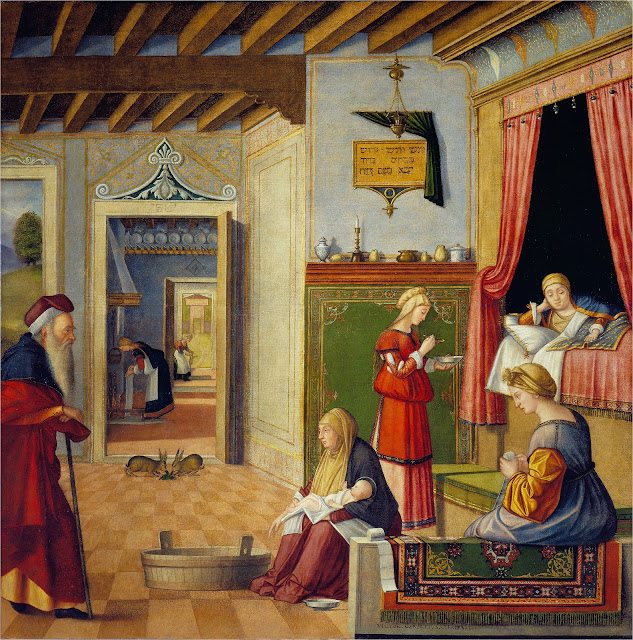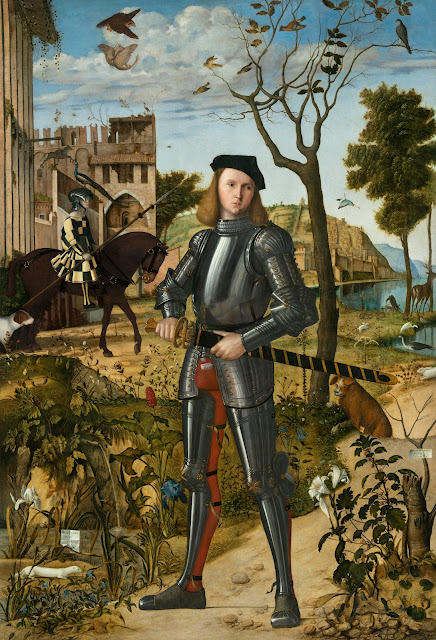National Gallery of Art,
November 20, 2022–February 12, 2023
March 18, 2023–June 18, 2023
A leading figure in the art of Renaissance Venice, Vittore Carpaccio (c. 1460/1466–1525/1526) is best known for his large, spectacular narrative paintings that brought sacred history to life. Celebrated in his native city of Venice for centuries, beloved for his observant eye, fertile imagination, and storytelling prowess, Carpaccio remains little known in the U.S.—except as a namesake culinary dish, "Steak Carpaccio.”
Vittore Carpaccio: Master Storyteller of Renaissance Venice is set to establish the artist’s reputation among American visitors with this, his first retrospective ever held outside Italy. The exhibition will be on view at the National Gallery of Art from November 20, 2022, through February 12, 2023. Some 45 paintings and 30 drawings will include large-scale canvases painted for Venice’s charitable societies and churches alongside smaller works that decorated the homes of prosperous Venetians. The exhibition is organized by the National Gallery and Musei Civici di Venezia, also the organizers of the 2019 exhibition Tintoretto: Artist of Renaissance Venice.
“The National Gallery of Art is pleased to partner, once again, with the Musei Civici di Venezia, this time to introduce American audiences to a lesser-known protagonist of the Venetian Renaissance, Vittore Carpaccio,” said Kaywin Feldman, director, National Gallery of Art. “Our visitors will be delighted by Carpaccio’s vivid and dynamic paintings that bring to life Venice in the 15th and 16th centuries. Through his masterful storytelling, Carpaccio illustrated the maritime empire during a fascinating period when it was a cultural crossroads between West and East. We are grateful to the many museums, churches, and collectors who have generously lent their works to share with the public in this historic exhibition.”
Several paintings have been newly conserved for the exhibition. Two of Carpaccio’s best-known canvases from the Scuola degli Schiavoni were treated with the support of Save Venice, the organization dedicated to the preservation of the city’s cultural heritage: Saint Augustine in His Study (shortly after 1502)and Saint George and the Dragon (c. 1504–1507). Other treatments uncover discoveries about the original compositions. National Gallery conservator Joanna Dunn’s treatment of the museum’s Virgin Reading (c. 1505) reveals a baby Jesus previously hidden beneath a later repainting that sought to disguise where the painting had been cut down centuries ago.
The two paintings from the Scuola degli Schiavoni are among several works never before exhibited outside Italy, including the full, six-painting narrative cycle, Life of the Virgin (c. 1502–1508) made for the Scuola di Santa Maria degli Albanesi. The exhibition also includes the reunification of Fishing and Fowling on the Lagoon (c. 1492/1494)from the J. Paul Getty Museum and Two Women on a Balcony (c. 1492/1494) from Venice’s Museo Correr—two paintings that likely adorned a folding door.
Exhibition Curators
The exhibition is curated by Peter Humfrey, internationally recognized scholar of 15th- and 16th-century Venetian painting and Professor Emeritus of art history at the University of St Andrews, Scotland, in collaboration with Andrea Bellieni, curator at the Musei Civici di Venezia, and Gretchen Hirschauer, curator of Italian and Spanish painting at the National Gallery of Art.
Exhibition Overview
Vittore Carpaccio: Master Storyteller of Renaissance Venice begins in the West Building’s West Garden Court with a special installation of Fishing and Fowling on the Lagoon (c. 1492/1494)and Two Women on a Balcony (c. 1492/1494). The two compositions were painted on the same panel of wood but were likely cut in half in the 1700s. When seen together, the paintings tell the story of two women sitting on a balcony while their husbands enjoy a day of sport on the Venetian lagoon. The panels are believed to have decorated folding doors that led into a domestic space in a Venetian palace. Here, they lead visitors into the exhibition.
The exhibition continues with an emphasis on Carpaccio’s innovations in Venetian painting. Early examples of private devotional paintings by the artist include Virgin and Child with the Young Saint John the Baptist (c. 1493–1496) from Germany’s Städel Museum, a unique depiction of the Virgin and Child as aristocratic Venetians of the 15th century. Another highlight of the exhibition is the reunification of the complete cycle of six canvases depicting the life of the Virgin Mary made for the Scuola di Santa Maria degli Albanesi. Carpaccio sets the story in Venice of his own day, blending details of Venetian architecture, furniture, and clothing with elements that evoke Jerusalem. Carpaccio also transposed scenes from classical mythology to contemporary Venice in other works like Departure of Ceyx from Alcyone (c. 1498/1503) from the collection of The National Gallery, London.
The exhibition includes examples from the three extant narrative cycles that Carpaccio was commissioned to create. His final narrative cycle made for the Scuola di Santo Stefano is represented by Ordination of Saint Stephen (1511) from the Staatliche Museen zu Berlin, Gemäldegalerie. Among the largest works in the exhibition is the Lion of Saint Mark (1516) from the Fondazione Musei Civici di Venezia, Palazzo Ducale. Spanning more than twelve feet, the painting shows the traditional symbol of Venice, a winged lion. The lion stands half in the sea and half on land, alluding to the vast sea-faring empire.
Carpaccio pioneered narrative subjects in altarpieces. The Martyrdom of the Ten Thousand Christians on Mount Ararat (1515) from the Gallerie dell’Accademia, Venice, was created to decorate the altar of the Ottobon family in the church of Sant’Antonio di Castello, which no longer exists. Its original context can be seen in another painting, Vision of Prior Francesco Ottobon (c. 1513), from the Gallerie dell’Accademia.
More of Carpaccio’s drawings survive than those of any other Venetian painter of his generation. Outstanding works on their own, the drawings include rough sketches for paintings presented in the exhibition, along with meticulous preparatory drawings for paintings too large to travel for this show. Preparatory drawings for a narrative cycle of the Life of Saint Ursula for the Scuola di Sant’Orsola, the artist’s first major commission, include a remarkable double-sided drawing Head of a Young Woman in Profile/Head of a Young Woman in Three-Quarter View (c. 1488–1489) from the collection of the Ashmolean Museum, University of Oxford.
Finally, an interpretive and reading room features View of Venice (1500), a remarkable woodcut by Jacopo de’ Barbari. Drawn from the National Gallery’s collection, the six-sheet print details Venice as it appeared in Carpaccio’s day and shows the thousands of buildings, squares, canals, bridges, gardens, and sculptures that filled the bustling city-state.
Exhibition Catalog
Copublished by the National Gallery of Art and Yale University Press, this 340-page illustrated catalog features essays by curators Peter Humfrey and Andrea Bellini along with contributions by other leading scholars exploring the full range of Carpaccio’s artistry and presenting new research on the extraordinary artist.
Sara Menato of the Fondo Ambiente Italia analyzes extensively Carpaccio’s drawings. Susannah Rutherglen, independent scholar and former exhibitions research assistant at the National Gallery of Art, illuminates Carpaccio’s narrative paintings for the Venetian confraternities known as scuole. Professor Deborah Howard, St. John’s College, Cambridge, explores the artist’s rendering of architecture. Professor Catherine Whistler of the Ashmolean Museum of Art and Archaeology, Oxford, offers her insights on Carpaccio as draftsman. Joanna Dunn, conservator at the National Gallery of Art, reveals elements of the artist’s pictorial technique. Professor Linda Borean, Department of Humanities and Cultural Patrimony, University of Udine, Italy, offers a historical perspective on early collectors and critics of Carpaccio. Andrea Bellieni of the Fondazione Musei Civici di Venezia shares his insights on the modern understanding of Carpaccio that began in the 19th century.

Vittore Carpaccio
Two Women on a Balcony, c. 1492/1494
oil on panel
overall: 94.5 x 63.5 cm (37 3/16 x 25 in.)
Fondazione Musei Civici di Venezia, Museo Correr, Venice

Vittore Carpaccio
Meditation on the Passion of Christ, c. 1494-1496
oil on panel
overall: 66.5 x 84.5 cm (26 3/16 x 33 1/4 in.)
framed: 87.9 x 105.7 x 7.6 cm (34 5/8 x 41 5/8 x 3 in.)
Lent by The Metropolitan Museum of Art, John Stewart Kennedy Fund, 1911 (11.118)










